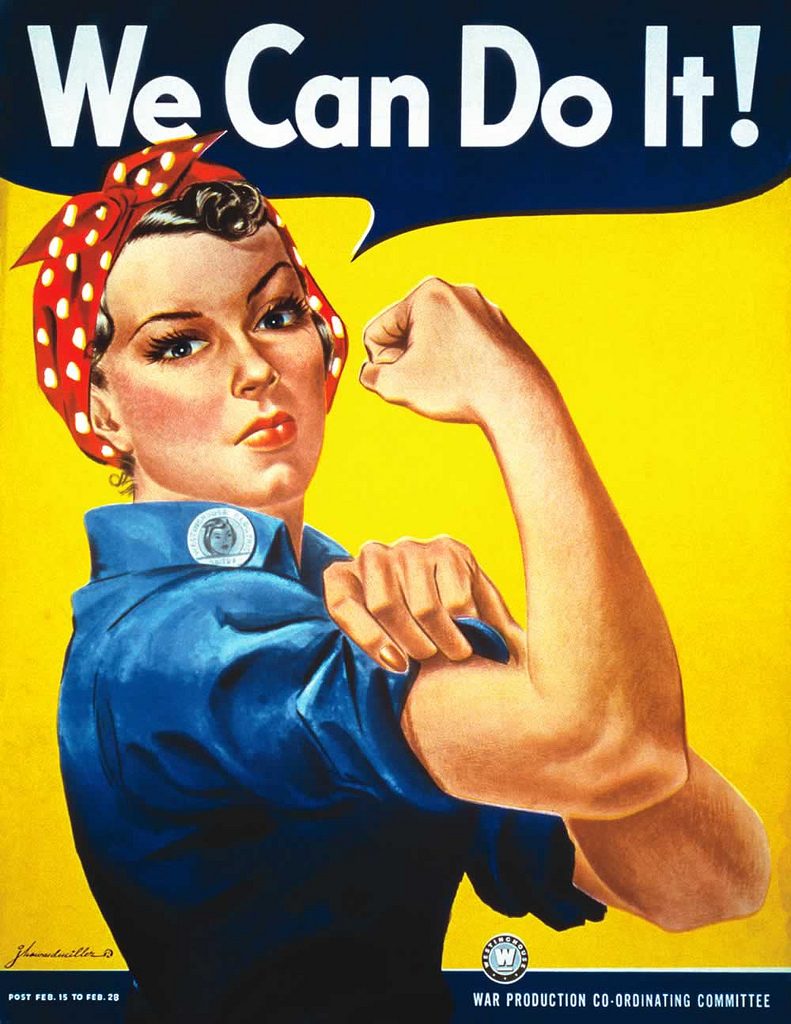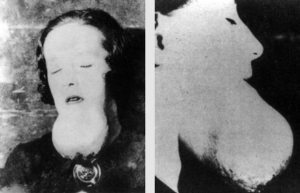From 1941 to 1945, during World War II, many woman were needed in the workplace because millions of men had joined the armed forces to fight in the European and the Pacific theaters of the war. In the Depression years just before this, women had been encouraged to stay at home, and let the men take the reduced number of manufacturing jobs available.1 With the onset of the war and the dramatically increased demand for manufactured wartime products, factories across the country opened their doors to women workers by the millions. In fact, there was a concerted effort to enlist women into the work force. In 1942, artist J. Howard Miller created the popular image of a woman named “Rosie the Riveter.” This poster was initially named, “We Can Do It!” and was made for the Westinghouse Electric and Manufacturing Company. Rosie was represented wearing makeup, a polka dot headband, and a rolled up sleeve shirt that portrayed strength and independence in women.2

Rosie the Riveter was a fictional character that many woman in the workforce identified with. The initial purpose of her image was to influence women to see themselves as capable of doing work previously thought to be men’s work. Her image combined beauty and strength, which is why many woman saw her as a role model. Even though Rosie the Riveter was a fictional character, her image was actually based on a photograph of a woman named Geraldine Doyle, who was a Michigan factory worker.3
There were some jobs that women took on that required training. Because of this, their wages were higher due to the fact that their jobs were more challenging and engaging compared to jobs that they may have had before. During the war, eighteen million women referred to themselves as being “Rosies.” Out of these eighteen million Rosies, six million had the opportunity to work for the first time. These women understood that the U.S. military and economy needed them; however, what motivated them to work was their own patriotism.4
In 1942, before Miller’s poster was created, Redd Evans and John Jacob Loeb wrote a song called, “Rosie the Riveter.” This hit song had lyrics that acknowledged and recognized the work that women did during the war:
All the day long whether rain or shine
She’s a part of the assembly line
She’s making history,
working for victory
Rosie the Riveter.
Keeps a sharp lookout for sabotage
Sitting up there on the fuselage
That little frail can do
more than a male will do
Rosie the Riveter.5
The song became associated with the existing images of Rosie the Riveter, which was a perfect blend of patriotism and beauty and strength in women.6
Unfortunately, after the war, the jobs and wages that Rosies had adapted to their lifestyles came to an end for the majority of them. Some went back to working “less challenging” jobs, and some became stay-at-home mothers. Because of this, birth rates increased, which led to the baby boom that lasted from 1946 through 1964. Even though many women went back to their previous lifestyles, they claimed to have left the workforce more confident and had more self-worth, knowing that they had proved to society that they were capable of doing men’s work.7
World War II changed the lifestyles of women significantly. Going from housewives to working in different industries allowed women to prove to society that this type of work was not just for men. There may have been no intention for women to prove themselves what they are capable of; however, women did leave their jobs after the war feeling better about themselves. Rosie the Riveter remains an iconic figure in American history, representing not only beauty in women, but also strength, courage, and confidence.
- Encyclopedia of Sex and Gender, 2007, s.v. “Rosie the Riveter,” by Susan L. Solomon. ↵
- America in the World, 1776 to the Present: A Supplement to the Dictionary of American History, 2016, s.v. “Rosie the Riveter,” by Nichola D. Gutgold. ↵
- Encyclopedia of Sex and Gender, 2007, s.v. “Rosie the Riveter,” by Susan L. Solomon. ↵
- Encyclopedia of Sex and Gender, 2007, s.v. “Rosie the Riveter,” by Susan L. Solomon. ↵
- Redd Evans and John Jacob Loeb, “Rosie the Riveter,” (New York: Paramount Music Corporation, 1942); The Four Vagabonds, “Rosie the Riveter,” recorded RCA Manufacturing Co., 1943. ↵
- America in the World, 1776 to the Present: A Supplement to the Dictionary of American History, 2016, s.v. “Rosie the Riveter,” by Nichola D. Gutgold. ↵
- Encyclopedia of Sex and Gender, 2007, s.v. “Rosie the Riveter,” by Susan L. Solomon. ↵



89 comments
Maria Mancha
Rosie is an icon especially to many feminist movements. I wasn’t familiar that there was a song about it, I just knew about the campaign posters. I hate how women worked so hard during this time period but when the men come back from war the women are treated as if they didnt do anything and they don’t get the equal treatment they deserve. Its the 21st century yet we are still having to fight these battles of being equal. This article did a great job of showing how women worked hard in textiles just to get it all taken away and pushed back into the household. Women were the backbone of the 1940s and are still the backbones of many families so its unfair that they don’t get treated equal to men. Therefore I really enjoyed this article and the information behind it.
Hanadi Sonouper
Rosie is such an iconic image to our history, especially for embracing the strong effort that woman contributed to our society and their ongoing success. I admire her symbolism for standing strong and having a powerful outlook for inspiring woman that they can do whatever the opposite sex can do. To this day her optimistic look still inspires millions of women to continue to pursue their dreams and believe that anything is possible.
Natalie Childs
I really enjoyed this article. I had seen the poster of Rosie the Riveter before, but I never really knew its origins. It’s incredible how this poster helped inspired women and made them to believe that they were more than capable to do the jobs men had for years. Not only did it help to spur women into work, and to show that they can have beauty and strength at the same time, it showed that it wasn’t just limited to the work place, which is shown with women leaving the work force with more confidence in themselves.
Samuel Stallcup
I always thought the women movement in World War II was interesting and inspiring, for it allowed women to showcase their skills. I feel it also showed that they did not deserve as much scrutiny that they received for the past 100 years. They proved it WAS NOT true that women were inferior to men. I liked this article because of the storytelling.
Angelica Padilla
I have always seen this poster, and costumes of Rosie the Riveter. I knew that she as dressed like that to depict strong independence for women. As well as trying to make a breakthrough for equality for men and women from equal pay. Rosie truly inspired the feminine revolution. The article is truly inspirational as well as Rosie the Riveter herself.
Kailan Pena
I’ve seen the Rosie the Riveter poster a lot as its such an important poster in American history, but I had no idea that’s what the poster’s called. I honestly thought the woman depicted, Rosie, was a real woman that they used for the ad campaign, but this article taught me that that’s not true. I like the message this poster set forth and I enjoyed learning more details about it as well.
Reese Lujan
At school in history class, there was always a picture of the “We can do it!” poster but it was never explained in detail the whole meaning behind the picture. Reading this article I got a better understanding and appreciation for the woman in the picture. It’s amazing to think that the woman stepping up during a time in need and took the role of their men while they were away. I didn’t even know they had a song that they would sing while they were working. I love the little details that were put into this article.
Constancia Tijerina
Back in high school there was only ever a 5-minute conversation of this art piece but never any talk of who and why this piece of historical and motivational art was ever invented in the first place and its impact on society; mostly towards women. This article is truly inspirational. Women working hard and showing their true independence of “if you can do it, so can I” and that is what probably struck the movement of women all over to be more independent of themselves and still have that feministic feature with beauty and hard work.
Josemaria Soriano
I consider myself a fervent advocate of gender equity. It is unfortunate that until today there are completely sexist societies, which defend their inequality by supporting culture. This is the most common and easy way to identify sexism. However, I have noticed a much less easy to identify. I mean how many female engineers one can find in a university. The results are really disheartening: the vast majority are men. Why, despite all attempts to empower women, does this gap remain in the world of engineering? The answers to this question are numerous, but I think the most appropriate is the lack of confidence of women to choose the path of engineering. How to solve this? the answer is in our past: Rosie the Riveter was a symbol that impeled a whole movement of feminine consciousness. This symbol was able to inspire a whole feminine revolution. Let us not blind ourselves, the path to gender equity is still long, but if we want to make a breakthrough we must begin by valuing and recognizing the great achievements and virtues of women. A fair society between men and women will be a society of the future, which we hope will be the future of our next descendants
Troy Leonard
this was a great article to read. I have always seen Rosie’s pictures all of the place but I never really knew what they met or what she stood for. it is amassing how she had such an impact on women back then even though she was a fictional person. she encouraged women to work and I didn’t know that it was tie to the war I had no clue